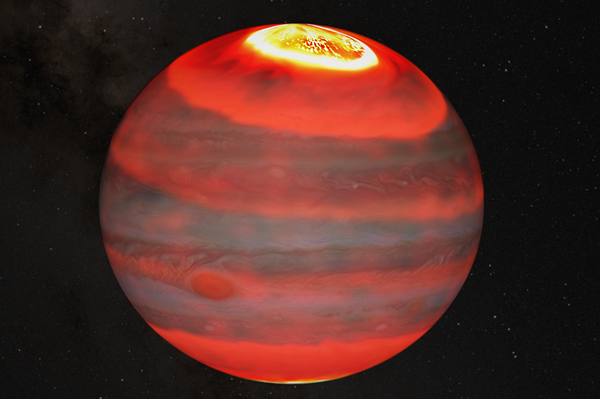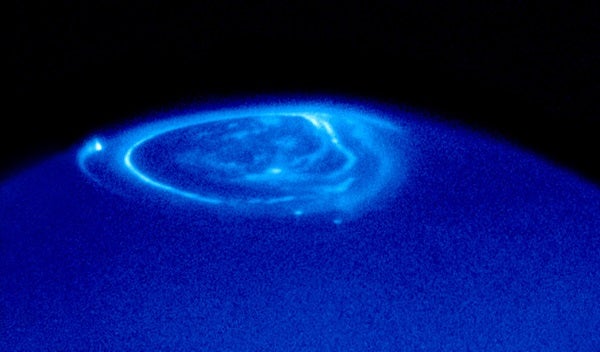For 50 years, researchers have struggled to explain one of Jupiter’s enduring mysteries: Why is its upper atmosphere so hot? Based on the intensity of sunlight Jupiter receives, its highest reaches should be a brisk −100 degrees Fahrenheit (−73 degrees Celsius). Instead, they sizzle at about 800 F (426 C).
One hypothesis held that Jupiter somehow generates heat from below — perhaps from storms lower in its atmosphere. Or, some speculated, its innards could still be gravitationally settling and releasing heat.
But the main suspect has been Jupiter’s aurorae, which are produced when the planet’s magnetic field traps charged particles and funnels them to its poles. When those particles smash into atmospheric molecules, they cause them to glow — and inject a tremendous amount of energy at the poles in the process.
While in principle, this could heat the entire planet, atmospheric models have predicted that the planet’s strong winds trap heat at the poles and prevent it from spreading to lower latitudes.
But a study in Nature published Aug. 4 suggests those models may be missing something. An international team of researchers used the Keck Observatory in Hawaii to measure infrared emission from hydrogen molecules in Jupiter’s atmosphere, producing a high-resolution temperature map of the planet.
Their analysis revealed that the polar regions directly under the aurorae were some 720 F (400 C) hotter than equatorial climes, clear evidence of the aurorae’s ability to heat the poles. And on the team’s second night of observations (Jan. 25, 2017, roughly nine months after their first), they also found evidence that this heat can spread elsewhere: A hot band appeared south of the main auroral oval, 360 F (200 C) warmer than its surroundings and wrapping halfway around the planet.
Auroral heat wave
The team argues this is a wave of heat traveling from the poles toward the equator. Strengthening their case, they note that the wave occurred at a time when the solar wind was predicted to be relatively strong at Jupiter, which would have triggered more intense auroral heating.
“It was pure luck that we captured this potential heat-shedding event,” said James O’Donoghue, a planetary scientist at the JAXA Institute of Space and Astronautical Science in Sagamihara, Japan, and the study’s lead author, in a press release. “If we’d observed Jupiter on a different night, when the solar wind pressure had not recently been high, we would have missed it!”
The team thinks this event shows the aurorae are likely responsible for most of Jupiter’s excess heat — though exactly how Jupiter’s atmosphere manages to circulate that heat remains unclear.











